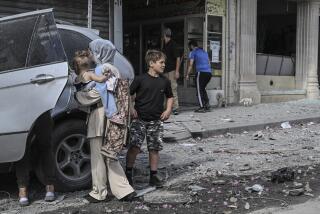Stinging Peace Prospects
- Share via
The next step in implementing the Reagan Doctrine apparently will be to place more sophisticated American weapons in the hands of the guerrillas around the world whom the President insists on calling “freedom fighters.” That would be a terrible mistake.
Initial reports have suggested that the mujahideen fighting the Soviet invaders in Afghanistan, and Jonas Savimbi’s UNITA guerrilla force fighting to overthrow the Marxist government of Angola in Southern Africa, would be the first beneficiaries of the new policy. Then, it is suggested, more such weapons would make their way to the contras seeking to overthrow the Marxist Sandinista regime in Nicaragua.
Among the top-line weapons under consideration for export to these groups is the Stinger surface-to-air missile, an anti-aircraft weapon that can seek out a target five miles away and up to an altitude of 4,500 feet. It would be particularly effective in downing helicopter gunships pursuing the guerrillas.
Advocates of the exports are convinced that the weapons would tilt the balance of war to the guerrillas. Perhaps. But even more certain would be an escalation of the wars. The Soviet Union, which supplies the governments in each of these nations, would have no choice but to send in deadlier weapons. However dim the prospect for negotiated settlements may be in these complex wars, that prospect would be all the dimmer with the introduction of these lethal missiles.
There is another chilling consideration. Especially in Afghanistan and at the bases in Pakistan that supply the guerrillas fighting the Soviet invaders in Afghanistan, there is slack security. Millions of dollars in weapons, intended for the resistance, already have fallen into the hands of a vast black market. Protection of a weapon of the value of a Stinger would be impossible. A great risk would arise that at least some of them would make their way into the hands of international terrorists. The Stinger is, as a recent report in the Christian Science Monitor pointed out, “the ultimate terrorist weapon.” They are easily hidden, easily transported, fired by a single person. No civil aircraft in the free world would be safe from them. And it is no comfort to say that it really doesn’t matter because the Soviet version of the weapon, the SA-7B, already is widely available.
There has always been a need for caution by Washington in the support that it has given to the resistance in Afghanistan. Afghanistan lies along the Soviet border, and Moscow can always outmatch and outsupply more distant nations. The level of arms there should be appropriate to the maintaining of pressure for a settlement, not to the triggering of a further terrible escalation of that brutal invasion.
Angola is an entirely different matter. Washington tends to forget that the Cuban troops and advisers that are based in Angola are in large measure in response to the guerrilla war that has been mounted against the government. This is not a case of a nation held hostage by an invading force. The only invading force in Angola has been the army of South Africa, arrayed in support of Savimbi’s guerrillas. There has been a commitment to a negotiated settlement breached not by Angola but by South Africa. The good faith of the Angolan government has been evident in its commercial ties to the United States that have assured the flow of its petroleum to the free world. Washington only squanders its power and corrupts its commitment to freedom in giving arms and comfort to the Savimbi guerrillas.
Introduction of the Stinger in the war in Nicaragua would risk even more serious consequences. The Sandinista regime in Managua has resisted activating the advanced fighter aircraft offered by its Soviet and Cuban allies, and a tacit weapons-technology lid has been placed on the war until now. But if the most advanced portable anti-aircraft missiles are handed over to the contras, an escalation of unpredictable consequences would be inevitable. The careful effortsof the Contadora nations to produce a permanent peace would be undermined, if not destroyed.
All three insurrections--in Afghanistan, in Angola and in Nicaragua--have in these days a new prospect for peaceful settlement. The impatience of those who somehow think that they can impose their will and their solutions should not be allowed, through the triggering of a new escalation, to shatter that prospect and to deepen the death and devastation of these wars.
More to Read
Sign up for Essential California
The most important California stories and recommendations in your inbox every morning.
You may occasionally receive promotional content from the Los Angeles Times.













